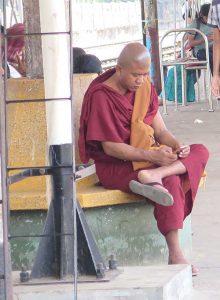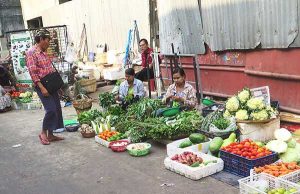By Victor Block
Part 2 of 2

Photo Victor Block
My first surprise was that a Buddhist monk in Myanmar (Me-un-mahr) speaks enough English to have a conversation. Imagine how astonished I was when he pulled a smartphone from his robe and showed me photographs of his recent trip to Japan.
Last month’s story described some of the fascinating attractions that greet visitors to Myanmar. Among the most memorable are the people of that country.
Itineraries planned by Myths and Mountains, the company with which I was traveling, provide plenty of opportunities for personal encounters, like the one my wife and I enjoyed with the monk. A high point of the trip, among many, occurred when he invited us to have lunch at the monastery that he heads.
Another was crossing paths with some of the 135 nationalities that comprise the country’s population. Members of each group cling proudly to their distinctive dialect, way of dress and traditions.
Some are among the people who toil in small workshops, turning out products that are as beautiful as they are useful. They put in long hours often for wages in the $3-to-$5 a day range.
I visited a shoemaker and silver smith, workshops for textiles and teak furniture, and shops where people cast bronze and carve wood. Even among such a varied sampling of mini-factories, each with its unique stories to relate, some linger in my memory. I was told that the shoemaker is the only one in the country who turns out special footwear for people with a disability.

A scene very different from the workshops awaits visitors to the ubiquitous outdoor markets that fill sidewalks and streets in cities, towns and villages. These are good places to meet and mingle with colorfully attired members of minority groups, some of whom are there to sell and others to buy.
Sidewalks are blanketed by vendors’ stalls, and streets are clogged with locals doing their shopping. Items are displayed on rickety stands and tiny tables and in some cases spread out on the pavement. Clothing may be next to flowers and near parts of animals, some of which were unidentifiable to me. Goods ranging from cooking oil to curry powder, fish to fowl, beads to baskets are displayed, inspected by passers-by and, occasionally, purchased.
To briefly summarize the challenges that working people in Myanmar face, many of the daily tasks are very labor intensive. I watched a man spend a full day cutting a lawn at a resort with a hedge trimmer, a task which could have been completed in an hour or so with a power mower. Young men wield heavy hammers for hours on end to pound slabs of gold into paper-thin leaf. Women toiling at road repair projects somehow manage to carry large heavy rocks on their head.
Contrasting with lifestyles that in many ways have varied little over time, vestiges of change also are evident throughout Myanmar. In cities, tiny dilapidated shacks stand near swishy shops that sell Armani, Rolex and other upscale merchandise. Streets are clogged by motor scooters, some carrying two adults and up to three small children, and trucks laden with unbelievably large loads.
To me some of the most interesting and intriguing sites were the villages that are scattered about the countryside, where people in many ways live much as their forebears did. Simple houses made of intertwined bamboo line narrow dusty lanes. Dogs, chickens and other animals wander free, in a constant search for food.
In contrast to those scenes, even in the tiniest and most isolated hamlets, are that cell phones are as ubiquitous as in any major U.S. city. Children of all ages use a smartphone to play games, and opportunities for taking photographs tempt the traveler around every turn.
In addition to Myanmar, Myths and Mountains operates tours and custom trips to a number of destinations in Asia and Southeast Asia. For more information call 800-670-6984 or visit mythsandmountains.com.
Part 1 of this story was published in the June issue and can found here.












